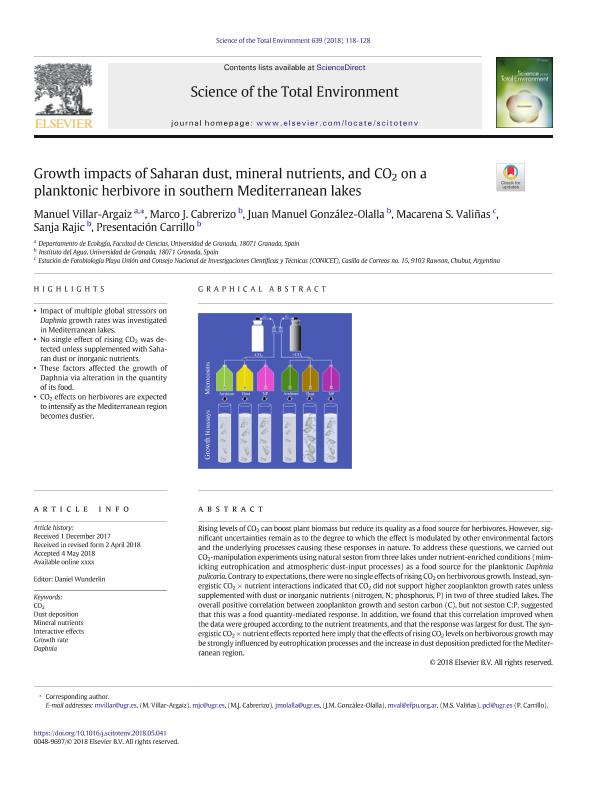Artículo
Growth impacts of Saharan dust, mineral nutrients, and CO2 on a planktonic herbivore in southern Mediterranean lakes
Villar-Argaiz, Manuel; Cabrerizo, Marco J.; González-Olalla, Juan Manuel; Valiñas, Macarena Soledad ; Rajic, Sanja; Carrillo, Presentación
; Rajic, Sanja; Carrillo, Presentación
 ; Rajic, Sanja; Carrillo, Presentación
; Rajic, Sanja; Carrillo, Presentación
Fecha de publicación:
10/2018
Editorial:
Elsevier Science
Revista:
Science of the Total Environment
ISSN:
0048-9697
Idioma:
Inglés
Tipo de recurso:
Artículo publicado
Clasificación temática:
Resumen
Rising levels of CO2 can boost plant biomass but reduce its quality as a food source for herbivores. However, significant uncertainties remain as to the degree to which the effect is modulated by other environmental factors and the underlying processes causing these responses in nature. To address these questions, we carried out CO2-manipulation experiments using natural seston from three lakes under nutrient-enriched conditions (mimicking eutrophication and atmospheric dust-input processes) as a food source for the planktonic Daphnia pulicaria. Contrary to expectations, there were no single effects of rising CO2 on herbivorous growth. Instead, synergistic CO2 × nutrient interactions indicated that CO2 did not support higher zooplankton growth rates unless supplemented with dust or inorganic nutrients (nitrogen, N; phosphorus, P) in two of three studied lakes. The overall positive correlation between zooplankton growth and seston carbon (C), but not seston C:P, suggested that this was a food quantity-mediated response. In addition, we found that this correlation improved when the data were grouped according to the nutrient treatments, and that the response was largest for dust. The synergistic CO2 × nutrient effects reported here imply that the effects of rising CO2 levels on herbivorous growth may be strongly influenced by eutrophication processes and the increase in dust deposition predicted for the Mediterranean region.
Palabras clave:
CO2
,
DAPHNIA
,
DUST DEPOSITION
,
GROWTH RATE
,
INTERACTIVE EFFECTS
,
MINERAL NUTRIENTS
Archivos asociados
Licencia
Identificadores
Colecciones
Articulos(SEDE CENTRAL)
Articulos de SEDE CENTRAL
Articulos de SEDE CENTRAL
Citación
Villar-Argaiz, Manuel; Cabrerizo, Marco J.; González-Olalla, Juan Manuel; Valiñas, Macarena Soledad; Rajic, Sanja; et al.; Growth impacts of Saharan dust, mineral nutrients, and CO2 on a planktonic herbivore in southern Mediterranean lakes; Elsevier Science; Science of the Total Environment; 639; 10-2018; 118-128
Compartir
Altmétricas



